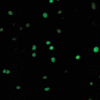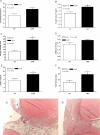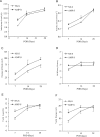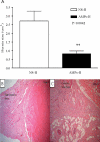Amnion-derived multipotent progenitor cells increase gain of incisional breaking strength and decrease incidence and severity of acute wound failure
- PMID: 18091982
- PMCID: PMC2064968
Amnion-derived multipotent progenitor cells increase gain of incisional breaking strength and decrease incidence and severity of acute wound failure
Abstract
Objective: Acute wound failure is a common complication following surgical procedures and trauma. Laparotomy wound failure leads to abdominal dehiscence and incisional hernia formation. Delayed recovery of wound-breaking strength is one mechanism for laparotomy wound failure. Early fascial wounds are relatively acellular, and there is a delay in the appearance of acute wound growth factors and cytokines. The objective of this study was to accelerate and improve laparotomy wound healing using amnion-derived multipotent cells (AMPs). AMPs' nonimmunogenic phenotype and relative abundance support its role as a cell therapy.
Methods: AMPs were injected into the load-bearing layer of rat abdominal walls prior to laparotomy, and cell viability was confirmed. Wound mechanical properties were measured over 28 days. The incidence and severity of laparotomy wound failure was measured in an incisional hernia model.
Results: AMP cells were viable in laparotomy wounds for at least 28 days and did not migrate to other tissues. Laparotomy wound-breaking strength was increased by postoperative day 7 following AMP therapy. AMP therapy reduced the incidence of hernia formation and the size of hernia defects. Histology suggested stimulated wound fibroplasia and angiogenesis.
Conclusions: AMP cell therapy reduces the incidence of laparotomy wound failure by accelerating the recovery of wound-breaking strength. This results in fewer incisional hernias and smaller hernia defects.
Figures







Similar articles
-
The use of amnion-derived cellular cytokine solution to improve healing in acute and chronic wound models.Eplasty. 2008 Apr 11;8:e21. Eplasty. 2008. PMID: 18470282 Free PMC article.
-
Early laparotomy wound failure as the mechanism for incisional hernia formation.J Surg Res. 2013 Jun 1;182(1):e35-42. doi: 10.1016/j.jss.2012.09.009. Epub 2012 Sep 23. J Surg Res. 2013. PMID: 23036516 Free PMC article.
-
Mechanisms and prevention of decrease in wound margin strength in intestinal anastomoses and laparotomy wounds.Acta Chir Scand Suppl. 1987;539:1-63. Acta Chir Scand Suppl. 1987. PMID: 3478929
-
The biology of hernia formation.Surg Clin North Am. 2008 Feb;88(1):1-15, vii. doi: 10.1016/j.suc.2007.10.007. Surg Clin North Am. 2008. PMID: 18267158 Free PMC article. Review.
-
Prophylactic mesh augmentation after laparotomy for elective and emergency surgery: meta-analysis.BJS Open. 2023 Jul 10;7(4):zrad060. doi: 10.1093/bjsopen/zrad060. BJS Open. 2023. PMID: 37504969 Free PMC article.
Cited by
-
Amnion-derived multipotent progenitor cells improve achilles tendon repair in rats.Eplasty. 2013 Jun 19;13:e31. Print 2013. Eplasty. 2013. PMID: 23814634 Free PMC article.
-
The effect of amnion-derived cellular cytokine solution on the epithelialization of partial-thickness donor site wounds in normal and streptozotocin-induced diabetic swine.Eplasty. 2009 Oct 20;9:e49. Eplasty. 2009. PMID: 19936023 Free PMC article.
-
The use of amnion-derived cellular cytokine solution (ACCS) in accelerating closure of interstices in explanted meshed human skin grafts.Eplasty. 2009;9:e12. Epub 2009 Mar 25. Eplasty. 2009. PMID: 19396338 Free PMC article.
-
The use of growth factors and other humoral agents to accelerate and enhance burn wound healing.Eplasty. 2011;11:e41. Epub 2011 Nov 7. Eplasty. 2011. PMID: 22084646 Free PMC article.
-
Intranasal Delivery of A Novel Amnion Cell Secretome Prevents Neuronal Damage and Preserves Function In A Mouse Multiple Sclerosis Model.Sci Rep. 2017 Jan 31;7:41768. doi: 10.1038/srep41768. Sci Rep. 2017. PMID: 28139754 Free PMC article.
References
-
- Dubay DA, Franz MG. Acute wound healing: the biology of acute wound failure. Surg Clin N Am. 2003;83(3):463–481. - PubMed
-
- Robson MC, Mustoe TA, Hunt TK. The future of recombinant growth factors in wound healing. Am J Surg. 1998;176(suppl 2A):80–82. - PubMed
-
- Franz MG, Kuhn MA, Wright TE, Wachtel TL, Robson MC. Use of the wound healing trajectory as an outcome determinant for acute wound healing. Wound Repair Regen. 2000;8(6):511–516. - PubMed
-
- Franz MG, Kuhn MA, Nguyen K, et al. Transforming growth factor b2 lowers the incidence of incisional hernias. J Surg Res. 2001;97(2):109–116. - PubMed
-
- Robson MC, Steed DL, Franz MG. Wound healing: biologic features and approaches to maximize healing trajectories. Curr Probl Surg. 2001;38(2):64–140. - PubMed
LinkOut - more resources
Full Text Sources
